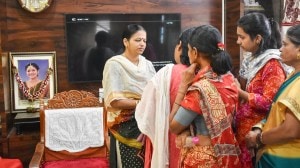- India
- International
Spread of education confined to a few regions in Maharashtra: Survey
While the GER is above 40 in regions such as Kolhapur, Pune, Aurangabad, Amravati and Nagpur, it is lower than 15 in Gadchiroli, Yavatmal, Washim, Buldhana, Parbhani and Latur regions.
 GER is the number of people enrolling in higher education out of every 100 people in the eligible age group of 18-23 years.
GER is the number of people enrolling in higher education out of every 100 people in the eligible age group of 18-23 years.
Maharashtra’s Gross Enrollment Ratio (GER) is better than the national average, but spread of education in the state is confined to a few regions, a recent survey has found. The overall GER for India is 25.8 but 31.1 for Maharashtra.
GER is the number of people enrolling in higher education out of every 100 people in the eligible age group of 18-23 years.
While the GER is above 40 in regions such as Kolhapur, Pune, Aurangabad, Amravati and Nagpur, it is lower than 15 in Gadchiroli, Yavatmal, Washim, Buldhana, Parbhani and Latur regions. In districts under MU, the overall GER is highest in Mumbai (52.7) compared to other districts such as Thane and Palghar, Raigad, Ratnagiri and Sindhudurg, where the GER is less than half of Mumbai. The worst GER in regions belonging to MU was among Scheduled Tribes in Thane and Palghar (6.37) and Ragaid (5.9) districts.
Read | At Delhi, AIIMS pays less, IIT more, Jamia the same
Compiled in a book titled, “Re-engineering Status of Higher Education in Maharashtra”, the survey is based on one lakh respondents across 11 non-agricultural state universities, of which 65,000 were students. Authored by Professor B N Jagtap, Principal Anil Rao and Anand Mapuskar, the book having consolidated data, analysis and guidelines was released on Monday by Governor Bhagat Singh Koshyari.

“This (GER) viewed from a different perspective also means that the spread of higher education becomes interconnected with the economic status of a district under consideration. In such a situation, positive intervention by the university and the government is needed to bring educationally backward districts in the fold of higher education,” the book says.
Video | JNU protests: Students clash with police outside campus, extra force deployed
In accordance with Maharashtra Public Universities Act 2016, state varsities declared their respective five-year perspective plans for 2019-24. The book consolidates present status of the universities in comparison to the growth projected in the perspective plans.
“In total, over two-thousand courses have been proposed by the universities. The big question is, are universities going to forcefully implement this? The idea behind bringing out the book is to bring university plans into public domain to encourage public participation in the process of holding universities accountable,” said Anil Rao.
The survey encourages universities to integrate skills in degree courses as “universities cannot remain isolated from the society”.
“One size cannot fit all. Our university systems work on elitist courses. If we’re promoting the concept of Swacch Bharat, we need to teach children on how to build scientific and cheap toilets. However, such things are construed as socially of a lower level. Local issues and livelihood generation can prove an important component of revenue model,” said B N Jagtap.
Some of the themes suggested by the authors to state universities for future include process optimization for jaggery industry, processing of jackfruit for Shivaji University, Kolhapur (SUK), career rehabilitation of disabled soldiers for Savitribai Phule Pune University (SPPU), heritage walks to promote tourism for SPPU, Mumbai University (MU), tribal art and handicraft for Dr Babasaheb Ambedkar Marathwada University (BAMU), and tourism promotion SPPU, MU, BAMU, and Punyashlok Ahilyadevi Holkar Solapur University (PASHU).
The survey also brings to light the dismal participation of state varsities in international games. During the years between 2015-2018, only five students from MU participated in Asian Games.
MU has the highest number of faculty involved in industrial projects (327) and MoUs with industry (252), followed by SUK. Only five departments of MU, and only 55 of its over 800 colleges have been academically audited for its teaching and learning process.
The survey points out, “Percentage of colleges graded A and above among the accredited colleges is another yardstick to assess the quality of higher education. Out of 1,140 accredited colleges in Maharashtra, only 350 colleges (30.7 per cent) have secured A grade and above.”
Sponsored | Empowering Leadership through AI Integration: Catalysing Business Transformation
Apr 26: Latest News
- 01
- 02
- 03
- 04
- 05








































